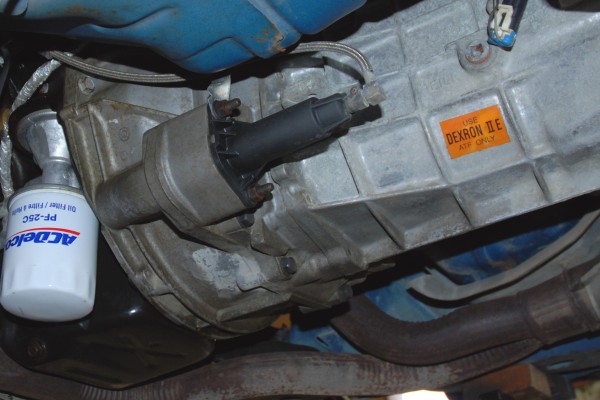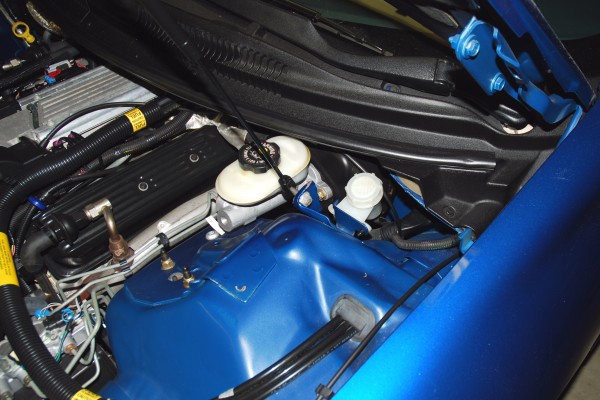There are two ways you can release a clutch on a car or truck—with mechanical linkage or via hydraulics. In this story, we’ll explore the hydraulic clutch.
Slave Cylinders vs. Hydraulic Bearings
There are two basic types of hydraulic clutches: slave cylinder and release bearing. In a slave cylinder system, a hydraulic cylinder is installed on the bellhousing and connected to a mechanical clutch fork. A clutch master cylinder feeds the slave cylinder. When you press on the clutch pedal, the pressure forces fluid from the master cylinder to the slave; the slave cylinder moves the clutch fork, which in turn activates the clutch release bearing.
Detroit has used various configurations of this system over the years. In some systems, the slave cylinder pulls the clutch fork; in others the slave cylinder pushes against the fork. The photo captions above will show you how a typical later model Chevy slave cylinder system is set up.
Several aftermarket manufacturers offer quality slave and master cylinders. Wilwood’s “pull type” slave setup is a good example. The slave cylinder is manufactured from billet aluminum and has a stainless steel pushrod with a longer stroke (1.38 inches) than most cylinders. That guarantees full clutch release. Wilwood designed the slave cylinder for use with a 7/8-inch bore master cylinder. If you have packaging issues under the hood, Wilwood offers their Compact Series slave cylinder. It has an ultra-short 3.37-inch body but provides 1.12 inches of stroke.
Slave cylinder systems are simple, but the hydraulic release bearing is simpler still. There is no slave cylinder or clutch fork. Instead, the clutch master cylinder applies hydraulic pressure directly to the bearing that engages the pressure plate fingers. A hose running directly from the clutch master cylinder to the master cylinder replaces virtually all of the mechanical parts.
There are several different designs of hydraulic release bearings available. One is the floating bearing offered by McLeod and others. This type of bearing works much like a regular release bearing, except it is engaged via hydraulics instead of mechanics. The other type is the fixed release bearing offered by Tilton. The bearing is either physically bolted to the inside of the bellhousing (you have to use a dedicated Tilton bellhousing for this) or it can be bolted to the transmission. When mounted directly to the gearbox, the stock input shaft retainer must be swapped for one of Tilton’s retainers. Tilton offers bearing/retainer packages for everything from vintage Muncies to modern Tremecs. They also offer a generic input shaft retainer that you can machine for not-so-common applications.
High performance hydraulic release bearings are “constant contact” types that provide quick clutch response. You will need to set a small operating clearance between the bearing and the pressure plate. Once you have the bearing properly adjusted for clearance, it will self-adjust for wear. That’s because there is no return spring required to pull the bearing’s piston back to the bottomed position. The piston within the assembly functions much like the piston in a brake caliper. Clutch pedal feel remains the same as the bearing wears, too.
Installation of a hydraulic release bearing is straightforward: Most bearings have a straight -3 AN union fitting installed for the master cylinder plumbing as well as a second -3 AN fitting for a bleeder hose. Tilton recommends a 7/8-inch bore master cylinder for a street clutch, while McLeod usually recommends a 3/4-inch bore master cylinder.
Determining Pedal Ratio
The key to a hydraulic clutch setup is getting the pedal ratio correct. In fact, it’s critical, and an inch or two can make all the difference in how the clutch performs. Just like a brake pedal, the clutch pedal acts as a lever to increase the force applied by the driver to the master cylinder. That force tells the master cylinder to send fluid to the release bearing or clutch slave.
If you examine a clutch pedal, you’ll see the pivot point (where the pedal moves) and the mounting point/hole for the master cylinder pushrod are quite often different. By varying the length of the pedal and/or the distance between the pushrod mount and the pedal pivot, you can change how much force (via your left leg) is required to energize the master cylinder. This is the mechanical advantage, or pedal ratio. What you need to do is to figure out a ratio that provides enough force to energize the master cylinder without requiring too much effort on your leg’s part.
Let’s start at the beginning. The typical adult male leg can exert roughly 300 pounds of force. If you’ve ever tried to single-leg press 300 pounds at a gym, you know that’s a bunch. When you’re figuring out the right pedal ratio for the clutch, shoot for a force number that is 1/3 or less than that 300 pound figure. That will make working the clutch much more comfortable.
Next, you have to translate that 100 or so pounds of leg force into approximately 600 psi. You can do this by changing the overall length of the pedal, but it’s usually easier (and far more practical) to shorten the distance between the pivot point and the master cylinder pushrod mount location by drilling a hole for a new pushrod location.
If you go overboard in the pedal ratio department, the clutch can become over-sensitive or touchy. So how do you get it right? First, you need some measurements:
- Height of the pedal from the very bottom through the centerline of the pivot point
- Center-to-center measurement through the pivot point and the clutch pushrod hole in the pedal lever
Using an aftermarket reproduction clutch pedal as the example, dimension #1 is 13.25 inches. There are two different stock pushrod holes available (measurement #2): three inches and 3.625 inches. To determine pedal ratio, divide figure #1 by #2. Here’s how the ratios look for our example:
13.25 / 3 = 4.41 ratio
13.25 / 3.625 = 3.63 ratio
The recommended pedal ratio with either a 7/8- or 3/4-inch bore clutch master cylinder is around 6:1, so we would need to drill a new pushrod hole approximately 2.2 inches from the pivot point to get the optimum pedal ratio (13.25 / 2.2 = 6.072).
Take a look at the photos and captions above to see how simple a hydraulic clutch system really is. In a few weeks, we’ll look at some mechanical linkage options.












Good article left..
Good information about hydraulic cylinders and its works. Especially slave and master cylinder relative work.
Thank you for simplifying this!
Just found your blog, its pretty good! Working on a VW trike for my disabled brother-in-law. Need a hyd. clutch setup. We got Outlaw handcontrol, 5/8″ bore, and a CNC pull slave cylinder. Not working. The handcontrol is very hard to operate and the slave is only pulling 3/8″. Understand ideally that bigger handcontrol bore (can’t seem to find any) and a smaller cyl. bore would work better together, but the bore size on the cyls. is not always available. Have any ideas or other avenues to try? Appreciate any info you might have!
Kevin
Thanks for reading! This is a toughie so we consulted the Summit Racing tech department. Keep in mind, the longer the lever on the master cylinder the more leverage you will have. This will make it easier for the strength of your grip to release this automotive style clutch. Keep in mind that the size of the pistons need to be the same so that 1 inch of stroke at the master cylinder will equal 1 inch of travel at the slave cylinder. Now, more leverage can be built into the system by also lengthening the clutch release arm. If leverage is good on the input side, it is equally as good on the output side!
Hello Kevin. I have just read your question here, I know you posted this some 3 years back but I am also disabled and have just bought a vw trike. I need to get a hand operated clutch for my 16oo beetle motor. Did you get it right and if so could you offer me some adise. Very best regards Brendan UK
Kev : there are 7/8″ motorcycle bores for handbar clutch there is also a 1″ bore as well lookup m&p catalogue for clutch master repair kits and you should get the sizes off that, Ebay is another source and wemoto.
good luck with the project as I know auto boxs for VW are scarce
Wayne,
I have a 6.6/1 ratio and cannot get to 6.0/1 (I’d only have to move the clutch hole center .020 to get that ratio and the hole is .34 dia). So could expand on what “over-sensitive or touchy” means when you talk about “going overboard” above.
’32 Ford 3 window coupe street rod w/4 speed.
[…] Tilton recommends a 7/8-inch bore master cylinder for a street clutch, while McLeod usually recommends a 3/4-inch bore master cylinder. via […]